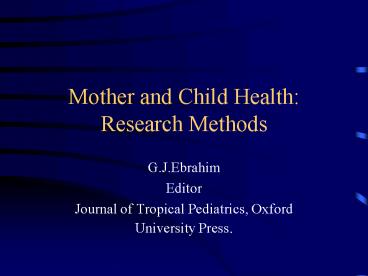Mother and Child Health: Research Methods PowerPoint PPT Presentation
1 / 11
Title: Mother and Child Health: Research Methods
1
Mother and Child Health Research Methods
- G.J.Ebrahim
- Editor
- Journal of Tropical Pediatrics, Oxford University
Press.
2
Bias
- Bias means different
- 3 types of bias
- Selection Bias
- Information Bias
- Confounding
3
Selection BiasExamples
- Patients referred for specialist care are
different from those in the community - Migration bias. People with chronic lung disease
tend to move out of urban areas those with
psychiatric problems seek the anonymity of cities - High dropout rates. Those who drop out of a study
tend to be different from those continuing
4
Information BiasExamples
- Response Bias occurs when subjects give
inaccurate responses. - Measurement Bias occurs when instruments are
faulty - Observer error
- A process tends to show improvement when being
observed. (Hawthorne Effect)
5
Strategies for Avoiding Bias
- Have clear and precise definitions (e.g. for
cases controlsexposurecriteria for
inclusion/exclusion) - Blinding where appropriate
- Reduce measurement error by quality control
- careful check of study design choice of
subjects ascertainment of disease and
exposureplanning of questionnaires methods of
data collection.
6
Confounders
- Confounders act by being associated with both a
risk factor and outcome in a way that makes the
two seem related.
Poor Maternal Nutrition
Low Birth Weight
Low Socioeconomic Class
7
Dealing with Confounders - 1
- Think about possible confounders at the design
stage, and gather data on all possible
confounders. - A quick test about a possible confounder is to
check whether it is unevenly distributed between
study and comparison groups. - Suspect confounding if the odds ratio gets
altered after adjusting for another factor.
8
Method of Checking for a Possible Confounder
- First calculate Odds Ratio for the exposure
variable. - Next calculate odds ratio for different strata
of the confounding variable - If the odds ratios are not materially different
then there is no confounding.
9
Strategies for dealing with Confounding
- Design Stage
- Strict inclusion criteria
- Matching
- Randomization
- Analysis Stage
- Do analysis by adjusting for several strata of
the confounding variable - Multiple regression analysis
10
Validity
- Are the conclusions true?
- Common threats to validity
- Selection bias
- Measurement bias
- Differential loss of subjects
- Confounders
- Unexpected events
- Hawthorne effect
11
Strategies for ensuring validity
- Have a control group. Helps against
confounding, unexpected events, Hawthorne
effect. - Random assignment of subjects to different
groups. - Before / After measurements.
- Carefully prepared research designs.
- Quality control of equipment
- Knowledge of environmental events especially if
the study is of long duration. - Unobtrusive methods of observation.

